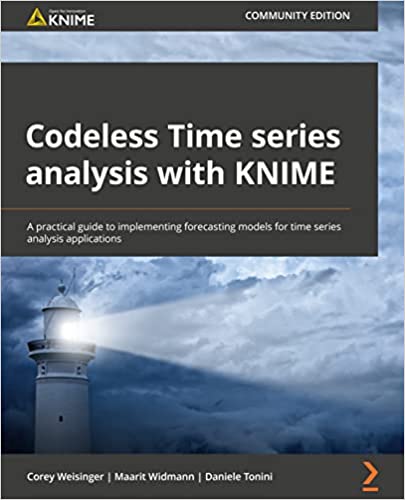Corey Weisinger is the author of Codeless Time series analysis with KNIME. We got the chance to sit down with him and find out more about his experience of writing with Packt.
Q: What are your specialist tech area(s)?
Corey: Data Science, Mathematics
Q: How did you become an author for Packt? Tell us about your journey. What was your motivation for writing this book?
Corey: Signal Analytics was my gateway into Data Science. I completed my studies with that interest in mind and only later came into Data Science as a field to apply them. With that in mind, I’ve been focusing on different types of Time Series Analysis for a while now. I first got involved with Packt as a technical reviewer for the Codeless Deep Learning with KNIME book.
Q: What kind of research did you do, and how long did you spend researching before beginning the book?
C: Research may be a strong word, but I’ve been building new Time Series functionality for KNIME and helping customers apply it to their use cases at KNIME. I’ve written quite a few blogs on the topic and figured it was time to take that to the next level and bring as many of those use cases as possible to a book. Along with some theoretical introduction.
Q: Did you face any challenges during the writing process? How did you overcome them?
C: Haha, I can only imagine how many times the editors at Packt have rolled their eyes in response to me. Yes, I took longer than intended to finish writing this book, partially due to some events in my personal life shortly after starting. I’m very happy with the outcome and to finally see it in print though. Thanks for your patience Packt!
Q. What’s your take on the technologies discussed in the book? Where do you see these technologies heading in the future?
C: Michael Berthold says it better than I do and is undeniably a more prominent figure to follow, but low-code or code-free tools like KNIME are becoming increasingly powerful and able to solve our technology problems with speed, and often efficiency, that is difficult to recreate in code. Particularly when moving projects into deployment or production. I still use Python of course, but I sometimes call KNIME my favorite IDE.
Q: Why should readers choose this book over others already on the market? How would you differentiate your book from its competition?
C: Codeless Time Series Analysis with KNIME will outshine the competition on two main fronts. First, it is amazing if you’re a KNIME user or curious about KNIME, but also it is ideal for gaining exposure to a blend of practical and theoretical approaches without the weight of a code based book.
Q. What are the key takeaways you want readers to come away from the book with?
C: I want readers to walk away from this book with awareness of several powerful techniques in Time Series Analysis, but also a respect for the business process. I often try to stress the importance of a concisely defined purpose – with this time series analysis becomes much easier.
Q. What advice would you give to readers learning tech? Do you have any top tips?
C: Concepts are more valuable than technologies; this is an opinion I’ve come to agree with more and more as I continue to work in tech. I can, and often do, google syntax; it’s much easier than googling “how to forecast”. Be comfortable working with new technologies – they’re always changing.
Q. Do you have a blog that readers can follow?
C: https://medium.com/@CoreyWeisinger and https://www.knime.com/blog
Q. Can you share any blogs, websites, and forums to help readers gain a holistic view of the tech they are learning?
C: https://www.knime.com/learning, https://forum.knime.com
Q. How would you describe your author journey with Packt? Would you recommend Packt to aspiring authors?
C: Working with Packt has been surprisingly easy. I’ve been a writer for quite some time, but this is my first feature-length film so to speak. The editors gave ample feedback but never altered my voice.
Q. What are your favorite tech journals? How do you keep yourself up to date on tech?
C: I’m not sure if I have a favourite journal… sometimes I find a great article on Medium, sometimes it’s Towards Data Science, and sometimes it’s YouTube. My favourite things to read are white papers – you know, those things ‘sometimes’ cited at the bottom of articles. I keep a folder of “Cool Papers” on my google drive so that it’s always synced to my tablet for easy reading haha.
Q. How did you organize, plan, and prioritize your work and write the book?
C: Oy, maybe this is the topic of another book or a blog at least. There are a million methods for keeping yourself on task and on schedule when writing and they all seem to work and not work at the same time. The advice I would give is “Don’t stare at the elephant”, the task is large but is accomplished one page, one paragraph, one oversized screenshot at a time.
Q. What is the one writing tip that you found most crucial and would like to share with aspiring authors?
C: Don’t think about the book, or even the chapter, just the page you’re on now.
You can find Corey’s book on Amazon by following this link: Please click here.









